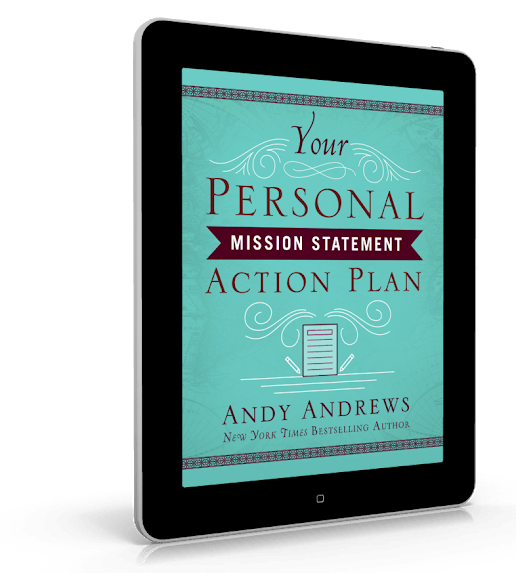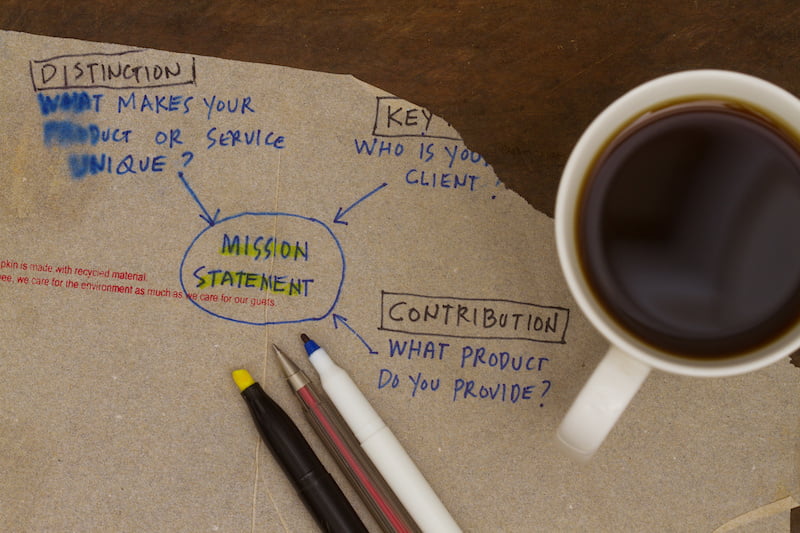The Ultimate Guide to Writing Your Own Personal Mission Statement
by Andy Andrews
If you’ve been on this planet long enough to work for a business or buy something from a business, you’re aware that just about all of them have one thing in common…
They have a mission statement.
While many of them are bland or miss the mark, there’s a reason why nearly every business has one.
Mission statements help businesses stay aligned with the values they find most important and ensure they’re staying focused on the way they want to impact the world. They can also help attract customers who share the same values.
So if mission statements are so critical that businesses often spend hundreds of hours crafting and fine-tuning them, why do so few people take the time to create their own personal mission statement?
The #1 Tool for Making Tough Decisions
A personal mission statement creates boundaries that allow you to play freely, create freely, and deal freely.
Everything you do—your investments of time, money, and relationships—should fit within the boundaries of that mission statement.
Boundaries, of course, aren’t the first thing that comes to mind for most people when they think about freedom. But they’re essential if you want to avoid distractions and free yourself up to focus on the things you find most important.
Consider this: a personal mission statement that sets clear boundaries is the number one tool for making tough decisions.
Why?
Because once you have set the boundaries for what you will and won’t accept in your life, when something comes up that is outside those boundaries, you don’t even have a decision to make. It’s that simple.
Many people spend so much time deciding whether they’re going to do something.
Is this good? Should I do it or not? What if I don’t do it?
They run it by everyone they know. They lose sleep over it. But it doesn’t have to be this way.
Living your life according to a mission statement is a more narrowly focused version of living your life according to principles.
Once you declare your mission statement, you begin living it. You don’t have to consider much outside it. The statement can be as long or as short as you like. Here’s mine for myself and my business:
My mission is to help others live the lives they would if they only knew how.
I spent a great amount of time thinking about that mission statement. It is the culmination of years of prayer, study, and experience.
5 Questions You Must Answer When Writing Your Personal Mission Statement
I created an in-depth worksheet that makes writing your personal mission statement much easier. It has templates, detailed instructions, and suggested next steps—download at the bottom of this page.
A meaningful personal mission statement isn’t something you can just pull out of thin air. There are, however, questions you can begin asking yourself every day that will move you closer to creating one:
1. What is important? What/whom do you value? How is your life connected to those things?
2. Where do I want to go? You can answer this many different ways. Your answer may involve a spiritual, mental, or physical destination. It might describe your career arc.
3. What does “the best” look like for me? Describe your best possible result. This isn’t the time to be realistic. This is the time to dream.
4. How do I want to act? How do you want people to describe you? Think of a few words you would want to come to mind when people think about you.
5. What kind of legacy do I want to leave behind? Imagine you’re 100 years in the future. What does the impact you’ve left look like? How is your Butterfly Effect still touching lives? Write down your answers to these questions and revisit them often. As you continue thinking about them, start giving your personal mission statement a shot. A few guidelines:
Keep it short. You want this to be something you can sum up in a single sentence. Remember, this is about focusing your life on what matters most! Boundaries will help you keep that focus.
Don’t forget about others. Yes, this is a personal mission statement, but it should be just as much about the people you want to impact as it is about yourself. Make sure that shows.
Share it with the most important people in your life. Get feedback from your spouse, your mentors, and any other important people in your life. They can provide you with invaluable insight.
It’s OK to make changes. As you grow and continue learning, your mission might evolve. That’s natural. As long as you’re staying true to the mission you know you were put here to accomplish, you can’t go wrong.
Personal Mission Statement Examples
Finding the perfect wording for your mission statement can be a challenge. To give you some inspiration, here are some examples readers have shared with me: “To inspire positive change through teaching and coaching.” “To create opportunities for today’s youth.” “To encourage, engage, and equip others to believe in the possibilities.” “To positively impact the life of every person I meet.” “To encourage everyone I interact with on a daily basis.” And, of course, my personal mission statement…“To help others live the lives they would if they only knew how.”
How to Determine If Something Is Aligned with Your Personal Mission Statement
I know that if a certain activity—what I’m learning, doing, reading, watching, or becoming—begins to steer me outside the mission I’ve established, I “grab the wheel,” regain the focus I lost there for a moment, and get on down the road I already decided to travel. I’ll give you an example…
Early on in my speaking career, when finances were very tight, I had been offered a deal from a very famous beer company to put a sign behind me when I was performing on college campuses. The offer they had made was more money than we had made in the previous two years combined, but I didn’t agonize over whether to accept or decline.
Heck, I never even considered it. I already decided several years earlier that I would not advertise alcohol or cigarettes. There were (and are) several reasons for this decision and though I hadn’t written a personal mission statements at that point, I had already established principles about how I was going to run the business and my lives. For many people, this might have been a difficult choice. But when you’ve already decided what you stand for, what your life is about, and what you will or will not do, you no longer need to weigh pros and cons when an offer arrives out of the blue. The hard work was done long ago. If something isn’t as clear-cut from the beginning and you do need to deliberate, consider the following questions to determine if it’s aligned with your mission statement: Is this opportunity/request/project:
- Part of who I am?
- Part of who I am working to become?
- Part of my purpose in life?
When God puts a vision in your life and puts dreams in front of you about where you’re going to go in life, how you’re supposed to live, and the impact you’re intended to have on this earth, he’s not fooling around. God doesn’t change his mind. God does not teach you to swim just to let you drown. And when you ask good questions (like the ones above), you discover what really fills your life with a sense of passion, purpose, and direction.
Bonus: Family Mission Statements
I think it’s absolutely necessary to have a mission statement for yourself and for your business, but even more so for your family. In the past, I’ve been hesitant to reveal my family’s mission statement because I never wanted to impose mine on anyone else. It is important for your family to think through your own. Carefully consider each word and phrase. Know why they belong. Our family’s mission statement should not be a template. Instead, use it as inspiration—a gift from me—a glowing ember upon which to build the flames of your own process. Here it is:
In the Andrews family, our mission is to arise each day with grateful hearts and smiling faces, determined to glorify, serve and trust in God. We live by the highest standards of moral character and integrity. We love, respect, encourage and defend each other. And we’re noble stewards of the resources entrusted to us.
Polly, the boys, and I sat down and asked ourselves the same questions I listed earlier:
What is important?
Where do we want to go?
What does “the best” look like for us?
How do we want to act?
What is the legacy we want to leave behind?
What is important?
Where do we want to go?
What does “the best” look like for us?
How do we want to act?
What is the legacy we want to leave behind?
Over the course of several weeks, we crafted the mission statement we finally declared ours. Today, every visitor in our home sees the statement we have made as to what our family is about. Most stop and read it, for The Andrews Family Mission Statement is framed and hanging in our front hallway. It makes life more intentional for Polly and me, but it is also transforming how our boys think and act. Whenever we are faced with a decision—individually or collectively—we refer to the mission statement to make sure what we choose is congruent with who we are and who we are becoming as a family. I urge you to work on your own mission statement. Not only does it provide clarity and direction for your purpose in life, it also helps you face every decision with calm and resolve, knowing in advance that what you choose will always be the best choice for you and your family. Question: What are some of the values that you will include in your personal mission statement?




